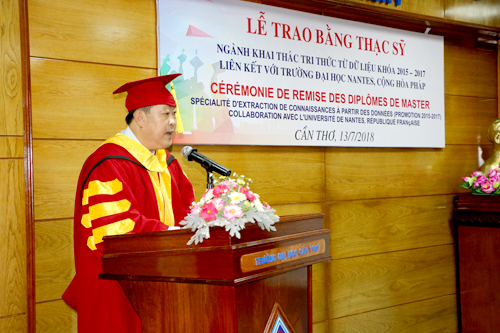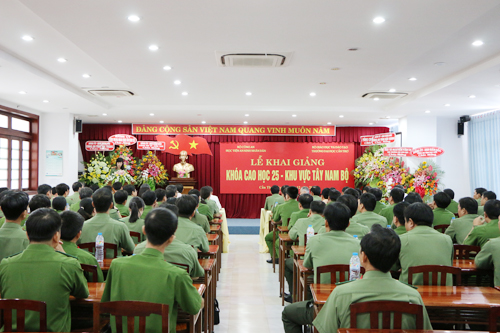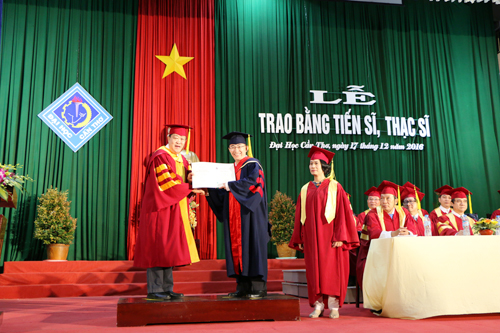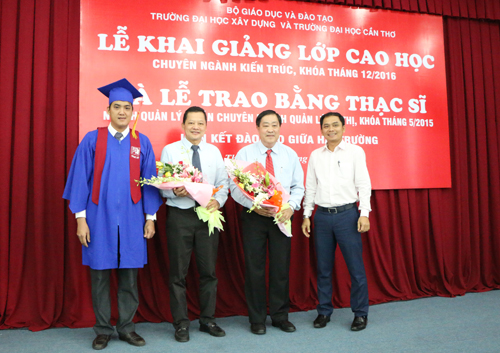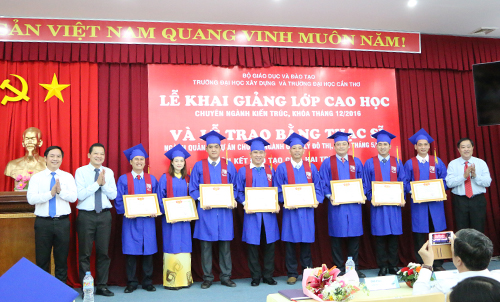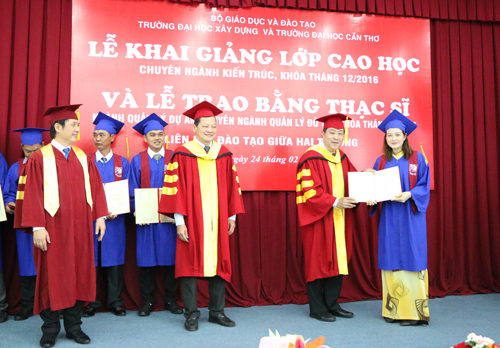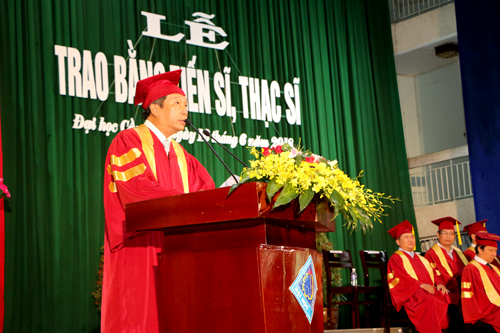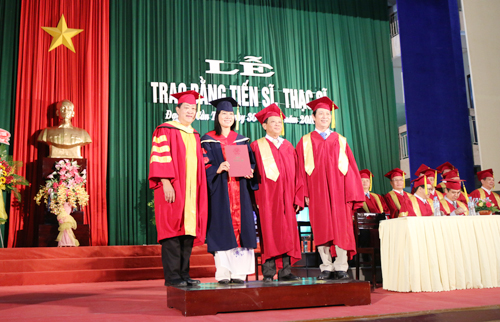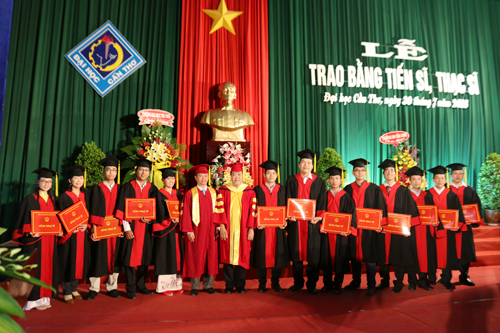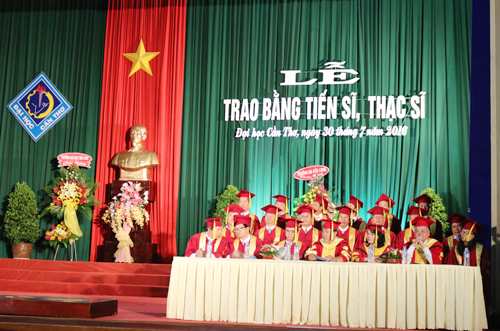
Tên đề tài: “Nghiên cứu biện pháp kích kháng bằng hóa chất đối với bệnh thán thư do nấm Colletotrichum spp. trên cây hành lá (Allium fistulosum L.)”
Tác giả: Nguyễn Quốc Thái, Khóa: 2016
Ngành: Bảo vệ thực vật; Mã số: 62620110. Nhóm ngành: Nông, lâm nghiệp và thuỷ sản.
Người hướng dẫn chính: PGS.TS. Trần Thị Thu Thủy - Trường Đại học Cần Thơ
- Tóm tắt nội dung luận án
Nghiên cứu được thực hiện từ tháng 8/2018 đến tháng 8/2022 tại Cần Thơ và Vĩnh Long. Nghiên cứu gồm 3 nội dung: (1) Thu thập, phân lập và đánh giá khả năng gây bệnh của các chủng nấm gây bệnh thán thư hành lá thu thập tại một số tỉnh trồng hành lá ở ĐBSCL, đồng thời định danh loài nấm Colletotrichum có khả năng gây bệnh nặng trên hành lá, (2) Xác định loại hóa chất với nồng độ và cách xử lý có khả năng kích kháng bệnh thán thư trên hành lá trong thí nghiệm ở nhà lưới và đánh giá hiệu quả kích kháng của các hóa chất trong điều kiện ngoài đồng, và (3) Khảo sát cơ chế kích kháng của hóa chất triển vọng qua biểu hiện mô học, sinh hóa và gen. Nội dung và kết quả đạt được như sau:
- Các chủng nấm gây bệnh thán thư trên cây hành lá được thu thập tại Vĩnh Long và Đồng Tháp đã được xác định là nấm Colletotrichum thông qua sự quan sát hình thái tản nấm và bào tử, cùng với kiểm tra triệu chứng bệnh và tác nhân gây bệnh theo nguyên tắc Koch. Chủng nấm PH3 thu thập tại xã Phước Hậu, huyện Long Hồ, Vĩnh Long là chủng nấm gây hại nặng nhất trên cây hành lá trong tổng số 20 chủng nấm này khi có tỷ lệ bệnh và chỉ số bệnh cao nhất. Loài nấm này được định danh bằng phương pháp quan sát hình thái và sinh học phân tử, thuộc phức hợp loài Colletotrichum gloeosporioides.
- Nghiên cứu về loại hóa chất với nồng độ và cách xử lý có khả năng kích kháng bệnh thán thư trên hành lá gồm 2 nội dung: i) đánh giá khả năng hạn chế bệnh thán thư hành lá bằng 2 phương pháp xử lý là nhúng gốc vào hóa chất hoặc phun hóa chất lên lá và ii) đánh giá khả năng hạn chế bệnh thán thư hành lá và gia tăng năng suất với số lần phun khác nhau. Kết quả cho thấy, khi được xử lý với hai hóa chất CaCl2, SA bằng cách nhúng gốc hoặc phun lá đều giúp giảm tỷ lệ bệnh, chỉ số bệnh thán thư hành lá tương đương nhau và khả năng này thay đổi theo nồng độ áp dụng. Sử dụng CaCl2 200 mM hoặc SA 2 mM giúp giảm tỷ lệ bệnh đến 13 ngày sau lây bệnh (NSLB), giảm chỉ số bệnh đến 11 NSLB, tương đương với CaCl2 300 mM hoặc SA 4 mM và tốt hơn so với CaCl2 100 mM hoặc SA 1 mM. Phun CaCl2 200 mM hoặc SA 2 mM từ 2-4 lần/vụ giúp giảm tỷ lệ bệnh và chỉ số bệnh tốt hơn phun 1 lần/vụ. Ngoài ra, phun 4 lần/vụ giúp giảm bệnh kéo dài đến 42 NSLB. Bên cạnh đó, phun 4 lần SA 2 mM còn cho hiệu quả giảm bệnh cao và gia tăng năng suất. Trong thí nghiệm ở điều kiện đồng ruộng, khảo sát hiệu quả của CaCl2 và SA trong phòng trừ bệnh thán thư, bệnh cháy lá và bệnh chết buội trên cây hành lá gồm 4 nghiệm thức (phun tán lá với CaCl2 200 mM; phun tán lá với SA 2 mM; xử lý theo nông dân là phun hỗn hợp hoạt chất trừ bệnh Bronopol + Metalaxyl + Hexaconazole; đối chứng phun nước), 4 lần nhắc lại, bố trí thể thức khối hoàn toàn ngẫu nhiên, mỗi lô thí nghiệm có diện tích 120 m2 tại huyện Bình Tân và Long Hồ, tỉnh Vĩnh Long. Kỹ thuật chăm sóc và phòng ngừa sâu hại được thực hiện như nhau giữa các nghiệm thức. Kết quả cho thấy, phun CaCl2 200 mM hoặc SA 2 mM định kỳ 10 ngày/lần, bắt đầu từ 15 ngày sau trồng có hiệu quả khá tốt trong việc hạn chế bệnh thán thư, cháy bìa lá và chết buội hành lá. Đối với bệnh thán thư, phun các loại hóa chất này làm giảm tỷ lệ bệnh và chỉ số bệnh sau lần phun đầu tiên. Hiệu quả giảm bệnh trung bình đạt tương ứng từ 53,7 - 57,1% tại huyện Bình Tân và 45,7 - 65,2% ở huyện Long Hồ. Bên cạnh đó, tỷ lệ bệnh cháy lá, chết buội cũng thấp hơn đối chứng sau 1 đến 2 lần phun. Đồng thời, khi phun chất kích kháng, năng suất thực tế đạt được từ 18,9-21,8 tấn/ha, năng suất thương phẩm đạt 15,0-18,7 tấn/ha và tỷ lệ thương phẩm đạt 79,4-85,8%, cao hơn so với đối chứng (lần lượt 16,8-17,6 tấn/ha; 11,9-13,1 tấn/ha và 70,7-74,7%).
- Xử lý CaCl2 200mM hoặc SA 2mM giúp làm gia tăng phản ứng phát sáng của
tế bào và sự tích tụ polyphenol trên cây hành lá, làm gia tăng hoạt tính của các enzyme peroxidase, catalase, β-1,3-glucanase và chitinase ở giai đoạn sớm sau nhiễm bệnh. Ngoài ra xử lý SA 2mM còn làm gia tăng hoạt động của gen tổng hợp chitinase ở thời điểm 6, 9 và 36 giờ sau lây bệnh (GSLB), trong khi CaCl2 thể hiện vượt trội ở thời điểm 12 GSLB.
- Những kết quả mới của luận án
- Đã xác định được nguyên nhân gây bệnh thán thư hành lá tại Việt Nam do ít nhất một loài Colletotrichum gloeosporioides gây ra;
- Đã chứng minh được 2 hóa chất CaCl2 và SA có tạo tính kháng trên cây hành lá chống lại nấm C. gloeosporioides gây bệnh thán thư dựa trên các phân tích mô học, sinh hóa và biểu hiện gen chitinase;
- Đã chứng tỏ 2 loại hóa chất CaCl2 và SA có tiềm năng áp dụng trong thực tiễn phòng chống bệnh thán thư hành lá.
- Các ứng dụng/khả năng ứng dụng trong thực tiễn, các vấn đề cần tiếp tục nghiên cứu
- Khả năng ứng dụng trong thực tiễn
Kết quả nghiên cứu sẽ góp phần mở ra chiến lược quản lý bệnh do nấm C. gloeosporioides theo hướng thân thiện với môi trường, đặc biệt áp dụng hóa chất có khả năng kích kháng giúp cây hành lá chống lại bệnh thán thư do nấm C. gloeosporioides.
- Các vấn đề cần tiếp tục nghiên cứu
Cần mở rộng phạm vi thử nghiệm hiệu quả của các chất kích kháng CaCl2 200mM, SA 2mM ở các vùng sinh thái khác nhau trước khi đưa vào khuyến cáo như là một biện pháp thân thiện với môi trường để kết hợp với các biện pháp khác trong phòng trừ bệnh thán thư trên cây hành lá.
Thesis title: Study on induced resistance to anthracnose disease on scallion plant (Allium fistulosum L.) caused by Colletotrichum spp. by chemicals
- Major: Plant Protection Code: 62 62 01 12
- Full name of PhD student: Nguyen Quoc Thai Year: 2016
- Scientific supervisor: Assoc. Prof. Dr. Tran Thi Thu Thuy
- Educational institution: Can Tho University
- Content of thesis summary
The study was carried out from August 2018 to August 2022 in Can Tho and Vinh Long provinces. The study consisted 3 contents: (1) Collection, isolation, and assessment of pathogenicity of scallion anthracnose strains collected in some provinces in the Mekong Delta, and identification of Colletotrichum species of causing severe index on scallion leaves, (2) Determination of induced chemicals with concentrations and treatments capable of managing anthracnose resistance on scallions in net house conditions; and evaluation of the resistance efficacy of induced chemicals in field conditions; and (3) Investigation of resistance mechanism of effective chemicals through histological expression, biochemistry, and gen expression. The results were as follows:
- The fungal strains causing anthracnose on scallion collected in Vinh Long and Dong Thap provinces were identified as Colletotrichum fungi through observing the morphology of fungal colonies and spores, along with examining disease symptoms and pathogene according to Koch's postulate. The PH3 strain collected in Phuoc Hau commune, Long Ho district, Vinh Long province was the most aggressive one on scallion plant out of total of 20 anthracnose strains collected in Dong Thap and Vinh Long provinces through a high disease index and disease severity. Beside, using the morphological observation methods and molecular biology, PH3 was identified as Colletotrichum gloeosporioides complex.
- The study to determine the concentration, method of treatment, and number of sprays of calcium chloride (CaCl2) or salicylic acid (SA) in the management of anthracnose disease on scallions was performed in two parts, including i) to assess the ability on decreasing the anthracnose disease using 2 treatment methods: stem dipping or foliar spray with CaCl2 and SA and ii) to assess the ability on decreasing anthracnose disease and increase yield using different spraying times of above- mentioned chemicals. The results showed that after treating with CaCl2 and SA both stem dipping and foliar spray, decreased anthracnose index and anthracnose severity similarly, and their efficacy depended on different concentrations. Applying CaCl2 200 mM or SA 2 mM reduced the disease index till 13 days after inoculation (DAI) and reduced the disease severity till 11 DAI, equivalent to CaCl2 300 mM or SA 4 mM and better than CaCl2 100 mM or SA 1 mM. Spraying CaCl2 200 mM or SA 2 mM on the scallion plants from 2 to 4 times reduced the disease index and disease severity better than once spraying treatment. Moreover, four sprays reduced the disease by up to 42 DAI. Besides, four sprays with SA 2 mM showed high disease reduction and increased yield. In the experiment in field conditions, the study to assess efficacy of CaCl2 and SA on controlling anthracnose, bacterial leaf blight and stem death diseases on scallion was carried out using four treatments (foliar sprays by CaCl2 200 mM; foliar sprays by SA 2 mM; a positive control as Bronopol + Metalaxyl + Hexaconazole and a negative control), 4 repetitions, arranged in a randomized complete block design, each experimental plot was 120 m2, in two districts Binh Tan and Long Ho, Vinh Long province. Insects management and planting techniques were the same between treatments. The results showed that foliar sprays by CaCl2 200 mM or SA 2 mM at every 10 days, starting from 15 days after planting, was effective on reducing disease severities of anthracnose, bacterial leaf blight and stem death. For anthracnose, spraying these chemicals reduced disease index and disease severity after the first spray. The average reductions of the disease were 53.7-57.1% in Binh Tan district; and 45.7 – 65.2% in Long Ho district. Besides, the disease indexes of leaf blight and stem death were lower than those of the negative control after 1 to 2 spray times. Moreover, when spraying CaCl2 200 mM or SA 2 mM, the actual yield from 18.9-21.8 tons/ha, the commercial yield reaches 15.0-18.7 tons/ha, and the marketability rate 79.4-85.8%, higher than the control (16.8-17.6 tons/ha; 11.9-13.1 tons/ha and 70.7-74.7%, respectively).
- Treatments of CaCl2 200 mM or SA 2 mM increased fluorescence response of host cells and polyphenol accumulation, as well as activities of peroxidase, catalase, β-1,3-glucanase and chitinase at the early stage after pathogen infection. Moreover, treatment of SA 2 mM also up-regulated gen of chitinase at 6, 9, and 36 hours after inoculation (HAI); meanwhile, treatment of CaCl2 200 mM highly expressed at 12 HAI.
- The novel aspects of the thesis
- The pathogen of anthracnose disease on scallion in Vietnam is at least one species of Colletotrichum gloeosporioides sensu lato.
- It has been proven that CaCl2 and SA stimulate resistance in scallion plants against the fungus C. gloeosporioides based on histological, biochemical, and chitinase gene expression.
- It has been shown that CaCl2 and SA can be used to manage scallion anthracnose disease.
- Application prospects and suggestions for further study
- Application prospect
The novel results contribute to opening up strategies for managing anthracnose disease caused by the fungus C. gloeosporioides on scallion in an environmentally friendly method, especially by applying chemicals to induce resistance.
- Suggestions for further study
It is necessary to expand the scope of testing the effectiveness of CaCl2 200 mM, and SA 2 mM in different ecological regions before being recommended as an environmentally friendly measure to combine with other measures in managing scallion anthracnose disease.
- Xem chi tiết nội dung luận án
- Xem thông tin đăng tải tại Website Bộ giáo dục và Đào tạo. (Nhập tên NCS vào ô tìm kiếm)





